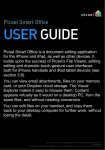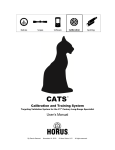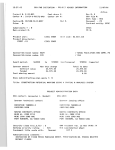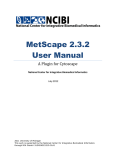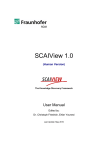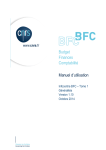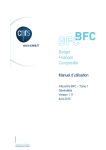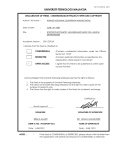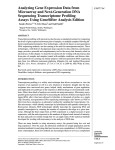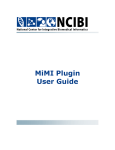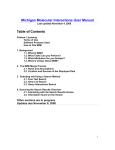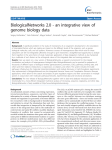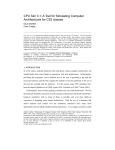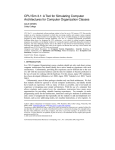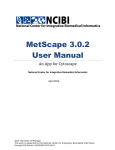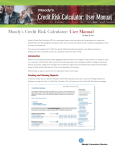Download Manual - ConceptGen
Transcript
Gene Set Enrichment Testing and Gene Set Relation Mapping Tool This work is supported by the National Center for Integrative Biomedical Informatics through NIH Grant# 1U54DA021519-01A1 Users Manual Version 1.0 Last updated November 24, 2009 ConceptGen CONTACTS ConceptGen Help [email protected] Website: http://conceptgen.ncibi.org National Center for Integrative Biomedical Informatics (NCIBI) The University of Michigan Medical School Palmer Commons Room 2017, Palmer Commons 100 Washtenaw Avenue Ann Arbor, MI 48109-2218 Phone: 734-615-5510 Fax: 734-615-6553 Website: http://www.ncibi.org Email: [email protected] National Center for Integrative Biomedical Informatics: NIH Grant # U54 DA021519 01A1 Page 1 ConceptGen Table of Contents CONTACTS .......................................................................................................................... 1 TERMS OF USE ..................................................................................................................... 3 General Use Policy ..................................................................................................................................3 For academic and non-profit institutions: ..........................................................................................3 For commercial and for-profit institutions: ........................................................................................3 Disclaimer ...................................................................................................................................................3 ABOUT CONCEPTGEN ......................................................................................................... 4 What is ConceptGen? .............................................................................................................................4 What Can You Do with ConceptGen? ..................................................................................................5 Tested Platforms .......................................................................................................................................5 Suggested Citation ...................................................................................................................................5 METHODS USED FOR CONCEPTGEN ................................................................................... 5 Concept Building .......................................................................................................................................5 Enrichment Testing (Overlap Possibilities) ............................................................................................6 Private concepts ........................................................................................................................................7 Background sets ........................................................................................................................................7 Gene Expression Analysis .......................................................................................................................7 Gene Set Relation Mapping- Network Graph ...................................................................................8 Gene Set Relation Mapping- Heatmap View ....................................................................................8 Gene-Gene Enrichment Analysis............................................................................................................8 USER REGISTRATION AND LOGIN ...................................................................................... 9 User Registration.......................................................................................................................................9 Login ............................................................................................................................................................9 Forgotten Password .................................................................................................................................9 UPLOADING GENE LISTS (PRIVATE CONCEPTS) ............................................................... 10 VIEWING RELATED CONCEPTS TO UPLOADED OR QUERIED GENE SET ........................... 11 Upper Left Concept Explorer Screen ............................................................................................ 11 Comparing Enriched Concepts to Uploaded or Queried Gene Set ............................................ 13 FILTERING ENRICHED CONCEPTS ...................................................................................... 14 VIEWING NETWORK RELATIONSHIPS ............................................................................... 15 Network Graph Viewer ....................................................................................................................... 16 Concept Detail .................................................................................................................................... 16 Customizing the Network Graph View ........................................................................................... 17 VIEWING GENE SET RELATIONSHIPS USING A HEATMAP ................................................ 18 Heatmap Viewer ................................................................................................................................... 18 Customizing the Heatmap View.......................................................................................................... 19 BROWSING CONCEPTS ...................................................................................................... 19 National Center for Integrative Biomedical Informatics: NIH Grant # U54 DA021519 01A1 Page 2 ConceptGen TERMS OF USE Supported through a grant from the NIH, the National Center for Integrative Biomedical Informatics (“NCIBI”) is one of seven National Centers for Biomedical Computing (“NCBC”) in the NIH Roadmap. Based at the University of Michigan, part of the UM Center for Computational Medicine and Biology (“CCMB”), the NCIBI develops efficient software tools, data integration methods, and systems modeling environments. This Suite of Tools and Data (the “Tools”) allows the Center to provide researchers with web-accessible knowledge analysis, collaborative work environments to create and utilize computationally-enabled models, and workflows to better understand complex biomedical processes. By agreeing to these Terms of Use governing the use of the NCIBI tools, you agree as follows: General Use Policy For academic and non-profit institutions: • • • • Permission is granted to access, use and/or download the Tools for internal use only; If the user desires to create derivative works of the Tools, source code or access to databases maybe made available through request to the NCIBI by e-mailing: [email protected]; Users must inform NCIBI of any derivative works of the Tools created (e-mail: [email protected]); Use of the Tools must be acknowledged in resulting publications (see citation policy below). For commercial and for-profit institutions: • • Permission is granted to access, use, and/or download the Tools for internal use only; To create derivative works of the Tools for commercial purposes, source code or access to databases may be permitted through negotiation for a commercial license. Please send request through: [email protected] Disclaimer THE USER AGREES THAT THE TOOLS ARE PROVIDED AS IS, WITHOUT REPRESENTATION OR WARRANTY BY THE UNIVERSITY OF MICHIGAN OF ANY KIND, EITHER EXPRESS OR IMPLIED, INCLUDING WITHOUT LIMITATION THE IMPLIED WARRANTIES OF MERCHANTABILITY AND FITNESS FOR A PARTICULAR PURPOSE. The Regents of the University of Michigan shall not be liable for any damages, including special, indirect, incidental or consequential damages, with respect to any claim arising out of, or in connection with, the use of these Tools, even if it has been or is hereafter advised of the possibility of such damages. Nothing in this license shall be deemed to grant any rights of the University of Michigan except as expressly stated herein. The names and trademarks of the University of Michigan may NOT be used in advertising or publicity pertaining to your use of the Tools, except as expressly stated herein. National Center for Integrative Biomedical Informatics: NIH Grant # U54 DA021519 01A1 Page 3 ConceptGen ABOUT CONCEPTGEN What is ConceptGen? ConceptGen is a gene set enrichment and gene set relation mapping tool that can help you identify, explore, and visualize relationships and significant overlaps among sets of genes (concepts). ConceptGen is built on a repository of conceptual data drawn from diverse areas. Data Type Source Functional annotations Gene Ontology (GO) Biological Process 1 GO Molecular Function GO Cellular Component Protein Domains (Pfam) 2 Kyoto Encyclopedia of Genes and Genomes (KEGG) 3 Pathways The Protein ANalysis THrough Evolutionary Relationships (Panther) 4 database Biocarta Pathways Literature derived Medical Subject Headings (MeSH) Online Mendelian Inheritance in Man (OMIM) 5 Targets Drug Bank target sets transcription factor binding targets microRNA predicted targets Experimental Gene Expression Omnibus (GEO) datasets 6 Interactions Protein-interaction databases – Michigan Molecular Interactions (MiMI) 7 Other Metabolites and Cytoband (chromosomal locations) ConceptGen finds gene sets that are significantly overrepresented from among the sub-categories (topics) comprising each of the above data sources. Significance of over-representation is measured by a modified The Gene Ontology Consortium. Gene ontology: tool for the unification of biology. Nat. Genet. May 2000; 25(1):25-9. Finn R., Tate J., Mistry J, Coggill PC, Sammut JS, Hotz HR, Ceric G, Forslund K, Eddy SR, Sonnhammer EL, Bateman A. The Pfam protein families database. Nucleic Acids Res. 2008; Database Issue 36:D281-D288. 3 Kanehisa M., Araki M., Goto S, Hattori M, Hirakawa M, Itoh M, Katayama T, Kawashima S, Okuda S, Tokimatsu T, Yamanishi Y. KEGG for linking genomes to life and the environment. Nucleic Acids Res. 2008. 36:D480-D484. 4 Thomas PD, Campbell MJ, Kejariwal A, Mi H, Karlak B, Daverman R, Diemer K, Muruganujan A, Narechania A. PANTHER: a library of protein families and subfamilies indexed by function. Genome Res. 2003. 13: 2129-2141. 5 Online Mendelian Inheritance in Man, OMIM. McKusick-Nathans Institute of Genetic Medicine, Johns Hopkins University (Baltimore, MD) and National Center for Biotechnology Information, National Library of Medicine (Bethesda, MD). World Wide Web URL: http://www.ncbi.nlm.nih.gov/omim/ 6 Barrett T, Troup DB, Wilhite SE, Ledoux P, Rudnev D, Evangelista C, Kim IF, Soboleva A, Tomashevsky M, Marshall KA, Phillippy KH, Sherman PM, Muertter RN, Edgar R. NCBI GEO: archive for high-throughput functional genomic data. Nucleic Acids Res. 2009 Jan; 37 (Database issue):D5-15. 7 Tarcea VG, Weymouth T, Ade A, Bookvich A, Gao J, Mahavisno V, Wright Z, Chapman A, Jayapandian M, Ozgur A, Tian Y, Cavalcoli J, Mirel B, Patel J, Radev D, Athey B, States D, Jagadish HV. Michigan molecular interactions r2: from interacting proteins to pathways. Nucleic Acids Res. 2008; 37(Database issue):D642-6. 1 2 National Center for Integrative Biomedical Informatics: NIH Grant # U54 DA021519 01A1 Page 4 ConceptGen Fisher's exact test (p-value) and is also shown by q-values. Q-values take into account the estimated proportion of false positives incurred (the false discovery rate) based on p-values. What Can You Do with ConceptGen? Gene Set Enrichment Testing • Upload a list of genes (larger lists tend to yield better results) to find other pre-defined concepts that are significantly enriched with genes in your uploaded set • Find relationships among those concepts Gene Set Relation Mapping • Enter a term/topic to retrieve and display predefined concepts that are semantically close to your entry • Find other concepts from the retrieved results that contain an over represented number of genes contained in the chosen Concept • Explore the network of relationships Gene – Gene Enrichment Analysis • Query a gene symbol to find related genes that share a significant number of annotations with the query gene (can be used to predict the pathway of action of genes with unknown function) • Query a gene symbol to identify all concepts to which that gene is assigned in ConceptGen Tested Platforms This software was developed and tested in Internet Explorer, Safari, and Opera on MAC and PC computers. In other browsers, and on other operating systems, i.e. Linux, results may differ. However, we will be glad to hear of any problems a user experiences and attempt to fix them. Email ConceptGen Help at: [email protected] Suggested Citation Sartor MA, Mahavisno, V; ConceptGen [Internet]. Ann Arbor (MI): National Center for Integrative Biomedical Informatics. 2009 Sept. Available from http://conceptgen.ncibi.org/core/conceptGen/index.jsp METHODS USED FOR CONCEPTGEN Concept Building ConceptGen defines concepts (gene sets) based on a wide variety of types of biological knowledge (concept types) with the goal of being able to identify novel relationships among diverse sources. Concepts and concept types are downloaded automatically or manually from various genomic resource centers, entries are converted to NCBI Entrez Gene IDs if necessary, and concepts are uploaded and stored in an Oracle database. In order to avoid non-informative or overly-vague concepts we limit the scope to between 5 and 1000 genes per concept. Gene Ontology, KEGG pathway, Biocarta Pathway, Panther Pathway, and Pfam information was downloaded from their respective source. Chromosomal location was determined by NCBI cytoband assignment, and gene expression signatures were defined as detailed in the Gene Expression Analysis Methods below. Other concept types were built as detailed here: National Center for Integrative Biomedical Informatics: NIH Grant # U54 DA021519 01A1 Page 5 ConceptGen Literature-derived concepts: Gene2MeSH (http://gene2mesh.ncibi.org) identifies gene-MeSH term pairs by testing whether the number of co-occurrences of each pair in the literature is significantly more than expected at random. MeSH concepts were generated from Gene2MeSH using a p < 0.001 cutoff for gene-MeSH term pairs. Human diseases: Online Mendelian Inheritance in Man® (OMIM®) was downloaded and manually curated to form unique concept names. Drug Targets: Data was downloaded directly from DrugBank (Wishart, et al., 2008). Transcription factor targets: TRANSFAC® 2008.3 database was used to directly assign transcription factors to their target genes. Protein-interactions: For protein-interactions we used the MiMI (Michigan Molecular Interactions) database, which deep-merges several sources of interactions, resulting in a comprehensive database of human protein interactions and thus great power/coverage to detect significant enrichments. MiMI concepts are defined by the protein-protein interactions centered at a specified gene, and were formed by including a central gene and all of its direct interactions (Tarcea, et al., 2008). MicroRNA targets: miRBase (Griffiths-Jones, et al., 2006) human predicted targets were downloaded and converted to Entrez IDs to form the miRNA target concept type. Metabolite-centered concepts: Metabolite concepts were defined using Edinburgh Human Metabolic Network database (Ma, et al., 2007). Each metabolite concept is comprised of genes encoding metabolic enzymes that catalyze reactions involving the respective metabolite. Enrichment Testing (Overlap Possibilities) Public concepts: All pairs of concepts from all concept types are tested for whether there exists a larger number of overlapping genes than is expected by chance. We use a slightly modified Fisher's exact test, termed the "Ease score" (Hosack DA, et al. Gen Biol. 2003 4(6):P4.) (see Figure below for how this is displayed in a 2-by-2 table). P-values are adjusted for multiple testing by calculating q-values using the FDR method (Benjamini & Hochberg. J of the Royal Stat Soc B. 1995. 57:289-300.) The default display is those concepts with q-value < 0.05, but the user may choose a different q-value or p-value cutoff. # in category # not in category # signif # not signif A-1 B 10 40 C D 200 9800 The hypergeometric distribution is used to calculate probabilities for overlap 𝑝𝑝 = (𝐴𝐴 − 1 + 𝐵𝐵)(𝐶𝐶 + 𝐷𝐷)(𝐴𝐴 − 1 + 𝐶𝐶)(𝐵𝐵 + 𝐷𝐷) (𝐴𝐴 − 1)! 𝐵𝐵! 𝐶𝐶! 𝐷𝐷! (𝐴𝐴 − 1 + 𝐵𝐵 + 𝐶𝐶 + 𝐷𝐷) Notice the test is invariant to switching rows and columns National Center for Integrative Biomedical Informatics: NIH Grant # U54 DA021519 01A1 Page 6 ConceptGen Private concepts Private Concepts (gene lists) uploaded by the user are converted to Entrez Gene IDs if necessary, and stored and tested in a private concept type. The identical modified Fisher's exact test is implemented, and q-values are calculated for the experimental list versus each concept type separately. Background sets A background set is defined as all genes (Entrez IDs) that were interrogated in creating the concept type. For example, for Gene Ontology concept types, the background set is all genes that are assigned to at least one ontology term. Users are provided the option for uploading a background set for each of their private concepts (gene sets). It is important to use the correct background gene set for each enrichment test, and for that we use the intersection of the background gene sets for the two concept types of the concepts being tested. Thus, for example, if we are testing a GO term versus a miRNA target list, we use all genes that are in both the GO background set and the miRNA target background set. Gene Expression Analysis In order to define expression-based concepts, we developed a custom-built gene expression analysis pipeline that uses a carefully chosen statistical method for each step. The gene expression concept type is populated with human Affymetrix experiments in Gene Expression Omnibus (GEO). We plan to update and expand this periodically. The analysis pipeline performs the following tasks: 1. Downloads the raw Affymetrix CEL files from GEO and the relevant experimental design information. 2. Using R, Probes are mapped to probe sets based on the relevant Entrez ID centered CDF package (Dai M, et al. NAR, 33, 2005). 3. Data is pre-processed and normalized using RMA. 4. Quality control output is manually observed, and only data passing our quality control standards proceeds. 5. Based on automatically extracted sample names provided by the author, comparisons are set up manually through a pipeline interface. 6. Differential expression is tested using an empirical Bayes, intensity-based moderated t-test (IBMT) (Sartor MA, et al. BMC Bioinf, 7, 2006), which provides better estimates of variance and improved ranking of significant genes compared to a standard t-test, especially for experiments of small sample size. 7. Gene sets (concepts) are defined by the top ranked genes, ranked by p-value, using the criteria fold change > 20% and p-value < 0.05, and limited to no more than 1000 genes. Note: We do not use the adjusted p-value for concept creation because, as opposed to identifying individual genes as significantly differentially expressed (when adjusting the p-values is necessary), identifying enriched concepts is improved by using a more relaxed significance cut-off (Sartor MA, et al., Bioinformatics, 2008). National Center for Integrative Biomedical Informatics: NIH Grant # U54 DA021519 01A1 Page 7 ConceptGen Gene Set Relation Mapping- Network Graph The graphical networks for gene set relation mapping are displayed using Adobe® FLEX/FLASH, and the force directed layout algorithm, which groups nodes that have a high degree of interconnectivity. The network has the following attributes: the concept type of each concept node is shown by the color as indicated in the legend, the size of the concept node is based on the number of genes in the concept, the thickness of the edge lines is based on the number of common genes. Gene Set Relation Mapping- Heatmap View The values used in creating the heatmap are defined by the counts of the enrichment concept pairs that a gene belongs to, and the genes and concepts are clustered using complete linkage hierarchical clustering with the Euclidean distance measure. Color of columns range from black (gene belongs to no enriched concepts) to bright red (genes belonging to the most enriched concepts.) Gene-Gene Enrichment Analysis Similar to gene set enrichment testing, a series of modified Fisher's exact tests are performed, but with genes replacing concepts, and concept membership replacing genes. For the application, q-values are calculated and a q-value < 0.01 cutoff is used as default. The gene-to-gene enrichment analysis provides a statistical measure of the closeness of any two genes by annotations, and can be reached through a link on the main ConceptGen website. It can also be used simply to query all concepts that any specific gene is assigned to in ConceptGen. National Center for Integrative Biomedical Informatics: NIH Grant # U54 DA021519 01A1 Page 8 ConceptGen USER REGISTRATION AND LOGIN ConceptGen is available at: http://conceptgen.ncibi.org User Registration In order to upload and save your private concepts (gene lists), you will need to register to create a user account. 1. Click on Register in the upper right hand corner. 2. On the User Registration form, fill in all fields (First Name, Last Name, Title, Institution, Department, Email, Password, Re-type Password). 3. Click the Register button. Login If you have already registered with ConceptGen previously, then proceed with the login procedures. 1. Click on Login in the upper right hand corner. 2. On the User Login page, fill in your email address that you used for registration and your password. 3. Click the Login button. Forgotten Password If you have forgotten your password: 1. On the User Login page (click on Login in the upper right hand corner), click on the “Forgot Password?” link. 2. Fill in your email address. 3. Click on the Submit Request button. Your password will be emailed to you. National Center for Integrative Biomedical Informatics: NIH Grant # U54 DA021519 01A1 Page 9 ConceptGen UPLOADING GENE LISTS (PRIVATE CONCEPTS) Once you have logged in, previously saved concepts will appear on the My Concepts screen. If you have not yet saved any concepts, this screen will be empty. 1. Click on Upload Concept in the upper right hand corner or the button next to the My Concepts header. 2. Fill in a new Gene List Name. 3. Select the radio button appropriate for the format of your gene identifiers. a. Entrez Gene Id (Human) Select this option for National Center for Biotechnology Information (NCBI) Entrez Gene IDs for humans b. Mouse or Rat Select this option for mouse or rat genes. Because ConceptGen is human-centric, mouse and rat genes will be converted to human homologs before they are uploaded. If you select this option, an additional screen appears to convert your gene list. i. Select the radio button appropriate to your species: Mouse or Rat. ii. Select the radio button appropriate for the format of your gene identifiers: Entrez Gene Id or Official Gene Symbol iii. Paste in the gene identifiers into the left box. iv. Click on the Convert to human homolog button. v. Copy the converted gene list that appears in the right box and paste in the appropriate box in the main window. c. Official Gene Symbol Select this option to upload official gene symbols. If you have a compound(s) rather than a predefined gene list, you can use the Compound to Gene converter which will create a gene list related to your compound(s) for you. Click on the [Compound to Gene] link. I. II. III. IV. Start to fill in the “Look up compound name” box. A drop down list of available compounds will display. Click on the compound of interest in the drop down list. Click on the button. Repeat until finished. OR 4. 5. 6. 7. Enter one or more compounds directly into the “Enter compound name here” box. V. Click on the Find Genes button. VI. Copy the gene list that appears in the box. Paste gene identifiers into Gene List box. Select the Background set appropriate for your gene species in the Background set dropdown menu. (Optional) If you are uploading microarray datasets or other datasets for which the complete human gene list was not assessed/measured, then select the Background Set Name radio button. (Optional) Fill in a new Background Set Name. National Center for Integrative Biomedical Informatics: NIH Grant # U54 DA021519 01A1 Page 10 ConceptGen 8. (Optional) Paste in the gene identifiers for the human genes background set in the Background Set List box. 9. Click on the Upload Gene List button. VIEWING RELATED CONCEPTS TO UPLOADED OR QUERIED GENE SET After clicking on the Upload Gene List button, the Concept Explorer screen appears with your gene list and its related concepts as shown in Figure 1. By default, only concepts with q-value < 0.05 are displayed. FIGURE 1. CONCEPT EXPLORER SCREEN Concept slices = proportionate # Protein–protein interactions Your gene list sorted by name Filter Tab Enriched Concepts Tab View – Details on Overrepresented Concepts for your gene Concept Type Test Statistics Upper Left Concept Explorer Screen The upper left corner of the Concept Explorer screen displays a gene list summary including the Queried Concept Name, Concept Type, and Gene List size and your gene list sorted by name. You also have the option to export the gene list to Excel by clicking the icon next to the Action label. Upper Right Concept Explorer Screen The upper right corner of the Concept Explorer screen displays a proportionate view of the types of concepts related to your gene list. Mousing over individual slices of the pie chart displays the Source, the percentage National Center for Integrative Biomedical Informatics: NIH Grant # U54 DA021519 01A1 Page 11 ConceptGen and number of related concepts. You can change the pie chart to view results as a bar chart by clicking on the icon underneath the pie chart and in the upper right corner of the Enriched Concept Tab portion of the Concept Explorer Screen. Enriched Concepts Tab of the Concept Explorer Screen The lower section of the Concept Explorer screen displays the default view of the Enriched Concepts tab. This tab shows details of the overrepresented concepts for your gene list. Sort results in the Enriched Concepts tab by clicking on the column header for the column by which you would like to sort. A small black arrow appears next to the sorted column and indicates the direction of the sort function. Export results in the Enriched Concepts tab by clicking on the icon in the upper right corner of the Enriched Concept Tab portion of the Concept Explorer Screen (next to the chart icon). National Center for Integrative Biomedical Informatics: NIH Grant # U54 DA021519 01A1 Page 12 ConceptGen Comparing Enriched Concepts to Uploaded or Queried Gene Set In order to compare a specific concept to your gene set: 1. Click on the desired concept of exploration in the Enriched Concepts tab on the Concept Explorer screen. 2. The Upper Left Corner of the Concept Explorer screen will display the enriched concept summary next to your gene list summary and includes the Enriched Concept name, Concept Type, Gene List Size (Figure 2). Your gene list summary will also be updated to include the Overlap number of genes between your gene list and the enriched concept. 3. Export the overlapping gene list to Excel by clicking on the enriched concept summary section. icon next to the Action label in the OR Go to the data source for the selected concept by clicking on the icon. OR View the protein interactions in the Michigan Molecular Interactions (MiMI) NetBrowser application by clicking on the icon. FIGURE 2. INDIVIDUAL ENRICHED CONCEPT CONCEPT EXPLORER SCREEN Your gene list summary Enriched concept summary National Center for Integrative Biomedical Informatics: NIH Grant # U54 DA021519 01A1 Page 13 ConceptGen FILTERING ENRICHED CONCEPTS You may filter the enriched concepts for your gene set by setting your filter preferences in the Filter Concepts tab of the Concept Explorer screen. 1. Click on the Filter Concepts tab in the lower portion of the Concept Explorer screen (Figure 3). 2. By default, all of the concept types in the Concept Type column are selected. To exclude any of these concept types, uncheck the box next to the concept type you would like to exclude. 3. Set the values for p- or q- values by sliding the arrows on their respective scales. 4. To activate the filters you have modified, click on the Execute Filter button. a. The chart in the Concept Explorer screen automatically updates to adjust for your filtered preferences. In order to view individual concepts, click on the Enriched Concepts tab to return to the Enriched Concepts tab view in the Concept Explorer screen. To reset the filtering function back to the standard settings, click on the Remove Filter button. FIGURE 3. FILTER CONCEPTS TAB CONCEPT EXPLORER SCREEN Filter Concepts Tab Stringency sliders National Center for Integrative Biomedical Informatics: NIH Grant # U54 DA021519 01A1 Page 14 ConceptGen VIEWING NETWORK RELATIONSHIPS To view relationships between concepts, 1. Select the concept types whose relationships you would like to explore in the Enriched Concepts tab view of the Concept Explorer. a. Select individual concepts by clicking on the check box next to the concept. OR b. Select concept types by clicking on the appropriate concept type on the chart in the upper right hand corner of the Concept Explorer screen (either the pie or the bar chart can be used to select concept types). 2. Click on the Draw complete interactions box if you would like to view links between all selected concepts and not just the links between your gene list and the enriched concepts (Figure 4). 3. Click on the Draw Network Graph button. FIGURE 4. NETWORK GRAPH OPTIONS FOR CONCEPT EXPLORER SCREEN Check to display cross concept links National Center for Integrative Biomedical Informatics: NIH Grant # U54 DA021519 01A1 Page 15 ConceptGen Network Graph Viewer Network Graph Viewer Symbols Meaning Node size Number of genes associated with that concept Node color Type of concept. See legend for specific concept types Edge thickness Number of overlapping genes Concept Detail To view the genes associated with a specific concept, double click on the node for that concept. The concept Detail screen will appear (Figure 5). The selected concept node will turn red. The genes that appear in the Concept Detail screen are all of the genes associated with that specific concept not just those genes from your original gene list. FIGURE 5. CONCEPT DETAIL IN NETWORK GRAPH VIEWER Selected node highlighted in red National Center for Integrative Biomedical Informatics: NIH Grant # U54 DA021519 01A1 Page 16 ConceptGen The Concept Detail screen displays: the Concept Type, size of the concept, and the genes (gene symbol and gene name) associated with that concept. Click on the button to export the list to Excel. Click on the button to view the protein interactions of the genes associated with this concept in the Michigan Molecular Interactions (MiMI) NetBrowser tool. Double clicking on a specific gene in the Concept Detail screen will open the gene detail information in the Michigan Molecular Interactions tool. Customizing the Network Graph View Action Function Click and dragging nodes or the background of graph Move nodes to desired location; move entire graph to a desired location Moving Motion-Stop Threshold slider Forces the movement of nodes to stop slower or quicker Adjust Graph Size slider Adjusts the length of the edges between nodes Clicking Clear Graph button Clears the graph; deselects all genes and returns you to the Concept Explorer screen Clicking Legend button Removes or adds the legend describing the node colors Clicking Explorer button Brings up Concept Explorer screen (click the X in the upper right hand corner of the Concept Explorer screen to return to the Network Graph View) Clicking Export Graph button Creates a PNG file format image of the screen in a separate window Clicking Open Gene Filter button Opens a screen that includes the Gene Symbols and Gene Names of your original gene list from which you can select specific genes to filter out which concepts are associated with that specific gene or genes. 1. Click on the box next to the gene symbol of the gene(s) for which you would like to see associated concepts. 2. Click on the Filter Graph button. ConceptGen will make transparent those concepts NOT associated with the gene(s) that you have selected, thereby highlighting the concepts associated with the selected gene(s) (Figure 6). To clear the filter selection, click on the Clear Filter button. Click on Close Gene Filter button Closes the Gene Filter screen National Center for Integrative Biomedical Informatics: NIH Grant # U54 DA021519 01A1 Page 17 ConceptGen FIGURE 6. GENE FILTER IN NETWORK GRAPH VIEWER Filtered out concepts VIEWING GENE SET RELATIONSHIPS USING A HEATMAP ConceptGen provides a heatmap view of the your gene set and its enriched concepts. To view relationships by using a heatmap view: 1. In the Concept Explorer window, select the concepts that you would like to view. You may click on the Select All link in the chart area if you would like quickly to select all of the enriched concepts. 2. Click on the Draw Heatmap button on the bottom of the Concept Explorer window. Heatmap Viewer Heatmap Characteristics Meaning X-axis Your gene list Y-axis Enriched concepts Color Redness indicates number of enriched concepts that include a specific gene National Center for Integrative Biomedical Informatics: NIH Grant # U54 DA021519 01A1 Page 18 ConceptGen Customizing the Heatmap View Action Function Moving Adjust Heatmap Size slider Resizes the heatmap Draw Tool button Allows you to draw a box around an area of interest and display the corresponding network graph (Draw Network Graph button) or the interactions in Michigan Molecular Interactions (Mimi NetBrowser) Clicking Draw Network Graph button Displays the Network Graph view Clicking Mimi NetBrowser button Opens a new window that displays the Michigan Molecular Interactions NetBrowser Clicking Network View button Displays the Network Graph view. When in the Network Graph view, this button changes to HeatMap View which allows you to switch between both views. Clicking Explorer button Brings up Concept Explorer screen (click the X in the upper right hand corner of the Concept Explorer screen to return to the Network Graph View) Clicking Export Graph button Creates a PNG file format image of the screen in a separate window Clicking Open Gene Filter button This function is only for the Network Graph view BROWSING CONCEPTS ConceptGen allows for browsing of pre-built concepts. 1. From the main search screen (click on the ConceptGen logo), type in a keyword into the search box. A drop-down list of matching terms will appear as you type. 2. Select a term from the drop-down list or finish typing all or part of your keyword. OR Click on the “Click here to browse all concepts” to browse all concepts organized by concept type. 3. Click the Search Concepts button. 4. Concepts matching your search criteria display with the gene list size and number of enriched concepts using a q-value of less than 0.5. 5. Click the drop-down arrow in the Sort By box to sort the list by Name, Gene List Size, Enrichment size, or Concept type (Figure 7). 6. Click the down arrow to the right of each result to export the corresponding gene list OR Click the right arrow for that concept. to the right of each result to open a new window with the source information National Center for Integrative Biomedical Informatics: NIH Grant # U54 DA021519 01A1 Page 19 ConceptGen 7. Click on the concept name to open the Concept Explorer window specific to that concept. FIGURE 7. BROWSING CONCEPT SEARCH RESULTS Partial keyword search term Result total Sorting options Search results list – click on concept name to open Concept Explorer window National Center for Integrative Biomedical Informatics: NIH Grant # U54 DA021519 01A1 Page 20





















